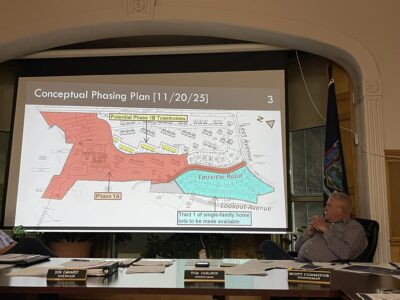Man-Made Chemicals Discovered In Chadakoin River

Janis Bowman, Chautauqua-Conewango Consortium member, is pictured collecting a Chadakoin River water sample to be tested for PFAS and included in the Waterkeeper Alliance’s national study. Submitted photo
PFAS has been discovered in the Chadakoin River.
PFAS, or per- and polyfluoroalkyl substances, is an organic group of chemicals that has existed since the 1950s, normally found in non-stick pans, water and stain resistant fabrics, and food packaging. More recently it has been used in fire-fighting foam.
Only recently it was discovered that these chemicals can be hazardous to humans. The current known health risks include increased incidence of cancer, liver and kidney disease, reproductive issues, immunodeficiencies, and hormonal disruptions.
The current standards set for measuring high or low levels of PFAS in surface water do not currently exist.
A national study, “Invisible, Unbreakable, Unnatural PFAS Contamination of U.S. Surface Waters”, was released Oct 18, 2022 by the Waterkeeper Alliance. They are the largest and fastest-growing nonprofit solely focused on clean water, dedicated to preserving and protecting water via local Waterkeeper groups worldwide. The Chautauqua-Conewango Consortium is the Waterkeeper Alliance Affiliate responsible for the Conewango Creek watershed.
The study was based on data gathered in late spring and early summer of 2022, when over 100 Waterkeeper groups collected 228 samples across 34 states plus the District of Columbia. Two of those samples were taken by representatives of the Chautauqua-Conewango Consortium from the Chadakoin River.
Before this study, the levels of PFAS in United States surface waters that serve as drinking water sources, recreational waters, and fisheries were unknown. No federal limits exist for PFAS releases into surface waters under the current Clean Water Act. The EPA is expected to set drinking water standards on two of the PFAS in 2023.
Because no standards for surface or recreational water that is not used for drinking exist as of yet, Jane Conroe, Vice-Chair of the Chautauqua-Conewango Consortium, said the situation is difficult.
“There are no standards for surface water so it is incorrect to say that the levels in the Chadakoin are high or low,” Conroe said. “In order to say that there has to be something to base it on and there is nothing right now. There are no standards for recreational or contact recreational water. For lakes there are class letters that they fall into for health standards depending on if they are used for drinking or recreation. For now it is collective chemical interim standards and health advisory levels that have been released by the EPA. At this point it is just, if there is a body of water that has it someone needs to know.”
Currently, two PFAS, PFOA and PFOS, have Interim Health Advisory levels set at 0.004 parts per trillion and 0.02 respectively. These levels are incredibly low, virtually zero. The Chadakoin River has 1.7 ppt PFOA and 1.8 ppt PFOS.
Conroe said the Chautauqua-Conewango Consortium will continue to be vigilant and test to see how extensive the PFAS spread is. At the moment they can only say for sure what they know to be true.
There is no current known way to reduce PFAS, as it is not breakable and can take thousands of years before it degrades. Conroe said there are some things people can do if they know for sure that they have it in their drinking water, such as get a new drinking water source, which is something that can be very difficult as well.
“There are very few ways to reduce PFAS,” Conroe said. “There is an incredible amount of research still to be done. Our response is to tell people what they need to know and what they can currently do. We hope to expand our monitoring. The question is now, how do we get rid of it?”
The full report is available at www.cccwaters.org along with more information about PFAS.



